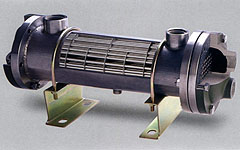Foshan KAMUI Heat Exchanger Co., Ltd. production of plate heat exchanger for maintenance?
Update:2013-02-19 Click:8222
(A), the common fault of diagnosis and treatment of
|
Status |
Reasons |
On policy |
|
Heat transfer performance |
Sheet-chip scaling |
Cleaning the plate, remove the dirt of the corner hole. |
|
Pressure drop increase |
Angle holes to plug, plate fouling | |
|
Outside Leak
|
Clamping force is not enough |
Control certification, the clamping size to tighten to the minimum size of the specified clamping above. Note that not less than the minimum size, so as not to damage the plate. |
|
Gasket damage, aging |
To injury, aging of the gasket replacement | |
|
Two gasket seals corrosion |
Replacement of corrosion of the gasket | |
|
The order of the plates mounted anti |
The control flow chart installation. Install the board and external was a regular hexagonal honeycomb. | |
|
Solid material between the plates |
Clean up the solids in the cubicle | |
|
Gasket shift |
The gasket seated properly in the gasket slot | |
|
Endoleaks, string fluid |
Plate perforations, cracks, corrosion |
Transmittance method, the "coloring", "pressure test" to check out the plate, replace the faulty plate. Specific methods, see the maintenance of plate heat exchanger |
(B) of the plate heat exchanger maintenance
A normal maintenance operation
①, in need of repair equipment, according to the order of installation retrograde disassemble the heat exchanger.
②, in petroleum, chemical industry equipment, shall be maintenance cycle for regular maintenance.
③, media equipment, explosive or corrosive media, at least annually should overhaul.
④, the plate heat exchanger used in other industries, without leakage, the best three years of maintenance time.
2, plate cleaning
The chemical cleaning method: a chemical solution to cycle through the heat exchanger, so that the plate surface of the dirt dissolve, discharge.
Mechanical (physical) cleaning method: manually scrubbing with a brush in accordance with the method of 8 plates apart.
Cleaning method: the dirt layer is relatively hard, thick. Soften the fouling layer using the chemical method, and then mechanical (physical) method to remove the dirt layer, to keep the surface clean, clean plate.
Precautions when cleaning
I, the chemical cleaning solution you want to maintain a certain flow rate, typically 0.8 to 1.2m / s. Its purpose is to increase the degree of turbulence of the solution.
Ⅱ, should be used for different dirt different chemical cleaning fluid. In addition to the often used in dilute soda ash solution for the scale with 5% nitric acid solution. Dirt generated in the production of soda ash, with 5% hydrochloric acid solution, but may not use chemical cleaning agent on the plate corrosion.
III, mechanical (physical) cleaning is not allowed to use carbon steel brushes to scrub the stainless steel plate, so as not to accelerate the corrosion of the plates. Can not make the plate surface scratches, deformation, etc..
Ⅳ, after washing the plate to rinse it and dry, should be placed to prevent plate deformation.
Ⅴ, cleaning water chlorine ion content ≤ 25ppm.
3, plate inspection
①, transmittance method: one side put the light source, to check on the other side.
②, coloring: according to JB4730 penetrant testing.
③, unilateral pressure test:
Plate assembly, unilateral pressure test. The other side of the plate moist is the damage at.
4, the replacement of the gasket (gasket for free sticky pad does not need the following process, directly and replace)
① will need to replace the gasket plate flat on the platform, using a flat screwdriver to gently pry be to change the gasket, and then tear off the entire gasket. Note that does not cause the the gaskets tank scratches.
②, with acetone, methyl ethyl ketone ketones organic solvent, clear gasket tank adhesive residue.
③, with a clean cloth or cotton to wipe the gasket groove and gasket.
④, the adhesive (excluding neoprene component) evenly on the gasket slot.
Clean gasket gasket tank attached to the plate.
Will be posted on a good gasket plate by Zhang to check, remove excess adhesive. On a flat, cool, well ventilated place naturally dry 4 hours before installation. Areas where conditions permit need to be heavy pressure on the plates.












